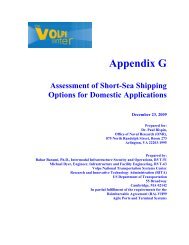ERRV Viking Islay - Marine Accident Investigation Branch
ERRV Viking Islay - Marine Accident Investigation Branch
ERRV Viking Islay - Marine Accident Investigation Branch
- No tags were found...
You also want an ePaper? Increase the reach of your titles
YUMPU automatically turns print PDFs into web optimized ePapers that Google loves.
All certification was valid, and there were no relevant conditions of class at the time ofthe accident.The ISM certificates, both the DOC for the owners Vroon and the Safety ManagementCertificate (SMC) for <strong>Viking</strong> <strong>Islay</strong>, were issued by the MCA. There were noobservations or non-conformities relevant to this accident at the time of the last audit.The Minimum Safe Manning Document was issued by the MCA. This required a crewof six to operate in the near coastal area 9 ; but due to <strong>ERRV</strong> operational requirements<strong>Viking</strong> <strong>Islay</strong> had a crew of 12 at the time of the accident.1.7.3Entering the chain locker and securing the anchor chainThe last fully documented entry to the chain locker was in June 2006, to allowsteelwork repairs to be undertaken by shore contractors. The Vroon SMS was correctlyused at that time.No evidence was found of the Vroon SMS system being used by the crew whenentering the chain locker to secure the chains. However there was evidence that thistask had been done before, probably on many occasions. There was also evidencethat this practice had occurred on other Vroon ships.1.8Vroon Offshore Services Ltd - The managers and operatorsAlthough a relatively new company, Vroon has a long pedigree in the North Seastandby business. BUE North Sea and <strong>Viking</strong> Standby Services merged in 2002, andthis company traded as BUE <strong>Viking</strong> from 2002 to 2005. BUE <strong>Viking</strong> became <strong>Viking</strong>Offshore Services in 2005, which in turn became Vroon in May 2007.As part of the Vroon expansion and investment strategy, both the DPA and DDPA wererecruited from the offshore industry, instead of the <strong>ERRV</strong> industry. The DPA was agraduate engineer with Merchant Navy and offshore project management experience.The DDPA, who was a graduate safety professional, was also the Quality, Health,Safety and Environment Manager.1.9ManningMany of the men on board <strong>Viking</strong> <strong>Islay</strong> had served with Vroon, or its previousincarnations, for many years and were regulars on this ship. Most of them hadextensive experience serving on board stand by vessels.The whole crew worked a 28 days on board, 28 days on leave routine. Watchkeepersworked conventional 4 hours on, 8 hours off watches while at sea, and the deckdepartment was enhanced by two day workers.<strong>Viking</strong> <strong>Islay</strong> was manned by a mixture of British and Polish nationals (both officers andcrew). English was the nominated language for all operations within the Vroon fleet.9 Within 150 miles from a safe haven in the UK.17
















